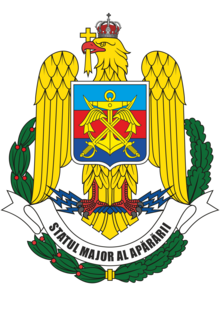The Romanian Armed Forces (Romanian: Forțele Armate Române or Armata Română) are the military forces of Romania. It comprises the Land Forces, the Naval Forces and the Air Force. The current Commander-in-chief is Lieutenant General Gheorghiță Vlad who is managed by the Minister of National Defence while the president is the Supreme Commander of the Armed Forces during wartime.
As of 2023, the Armed Forces number 81,300 active personnel and 55,000 reserves. The Land Forces have a reported strength of 35,500, the Air Force 11,700, the Naval Forces 6,800, and Joint Forces 17,500, in 2023.[10] Total defence spending currently accounts for 2.44% of total national GDP, which represents approximately 8.48 billion US dollars.[11] The Armed Forces are built for territorial defence, with support to NATO and EU missions, and contributions to regional and global stability and security.[10]
Military service is voluntary in peacetime (since 2007), and compulsory in case of curfew, war, or national emergency.[12][13][14][15]
- ^ "Șeful Statului Major al Apărării". defense.ro.
- ^ "Romania Ends Conscription". Radio Free Europe/Radio Liberty. 8 April 2008.
- ^ "Romania Military Strength". Global Firepower. Retrieved 7 November 2024.
- ^ International Institute for Strategic Studies 2023, p. 126.
- ^ Cite error: The named reference
smapwas invoked but never defined (see the help page). - ^ "Romania's Defence Ministry has EUR 8 BLN budget in 2024, 25% up from last year". 26 January 2024.
- ^ "Romania's Defence Ministry has EUR 8 BLN budget in 2024, 25% up from last year". 26 January 2024.
- ^ "FOTO Coreea de Sud și România se angajează să coopereze în domeniul apărării. Sunt informații despre încheierea unui contract pentru livrarea de obuziere K9, în valoare de 725,7 milioane de dolari. În paralel, și Polonia cumpără arme de la Seul".
- ^ [1] Archived 2015-01-18 at the Wayback Machine Gandul, 13 January 2015.
- ^ a b International Institute for Strategic Studies 2023, pp. 140–141.
- ^ "Defence Expenditure of NATO Countries (2014-2023)" (PDF). NATO. 7 July 2023. Retrieved 12 July 2023.
- ^ "Country report and updates". War Resisters' International. 15 June 2023. Retrieved 19 May 2023.
- ^ "Romania Ends Conscription". Radio Free Europe/Radio Liberty. 8 April 2008. Retrieved 19 May 2023.
- ^ "End to National Service Cheers Young Romanians". iwpr.net. Retrieved 19 May 2023.
- ^ "LEGE 446 30/11/2006 - Portal Legislativ". legislatie.just.ro. Retrieved 19 May 2023.
